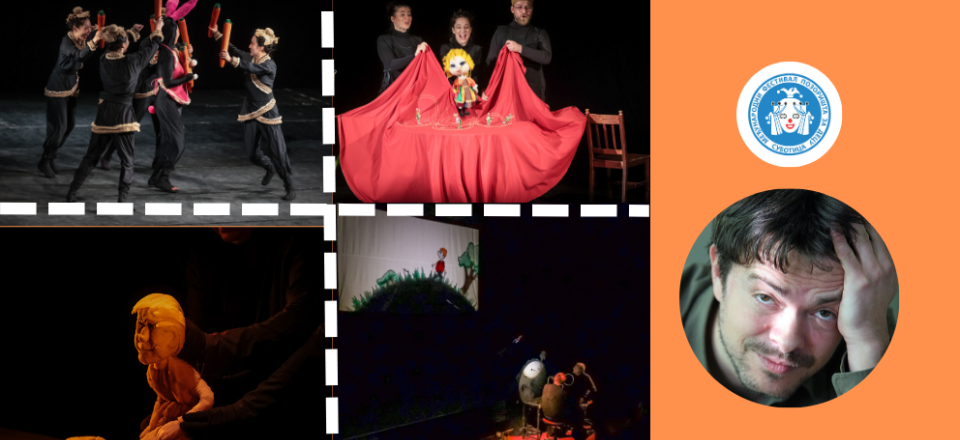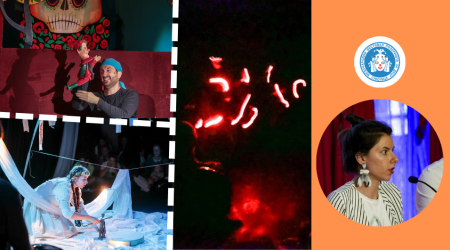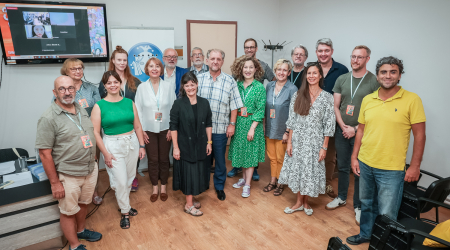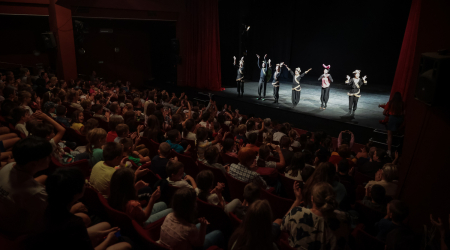Archived
In theater and on the railroad
Back to...
In theater and on the railroad
Igor Burić
In theater and on the railroad When I learned that the Children's Theatre of the China Welfare Institute was going to perform The Art of War I was excited for two reasons. Firstly, because Sun Tzu’s Art of War is an essential read - whether you have an interest in Eastern philosophy or simply because it’s so often referenced in Western pop-culture; secondly - because the Chinese people have a welfare institute. The play’s introduction would provide me with a third excitement (more of a surprise). A barren stage and the ensemble’s collective play pointed towards a simple yet focused choreography from which the figures of a hare and a tortoise began to emerge. To be more precise – figures of bunnies and turtles. This gender polarization - like everything else in the play – will ultimately prove to have not so simple and unequivocal repercussions. “Well, this is Aesop's fable and not Sun Tzu's philosophy of warfare and life!”, I was disappointed, amusing myself with cheap jokes about how this is typical, like the goods from a Chinese mall – shiny, but does not work. However, little by little, by watching the Turtle become aware of his surroundings each time he starts a race (which the director resolved using a type of stop-motion), by noticing how the characters and their relationships gradually change, how carefully chosen the participation of other actors is in sequences when they animate the props… I felt deeply drawn into the play. And it wasn't just the sweet bunny’s tail or puffy paws which the actress knew how to caress gently. It wasn't even a moment when her ears folded in half which made her very sad. The Turtle’s character, like a boy-ninja, was also well-likable and his every move was clearly defined. But my mood wasn’t affected by that either. In the middle of the play - when the race becomes one never-ending slow-motion and a sense of pointlessness begins to emerge, the Bunny and the Turtle become directed towards each other in a completely different, non-individualistic and non-competitive manner. Ultimately, when the Bunny is injured, the Turtle carries her on his back, and - with the final dramaturgical intervention - the famous story ends significantly differently from Aesop's. What follows is a return to collective choreography - once again emanating with Eastern wisdom - all characters emerge and return to the function of the community. I was amazed. A small addition to this review is a recommendation for another "play" citizens of Subotica can view downtown these days - from the pedestrian bridge above the railroad. The Chinese are laying down rails around the clock. I have enormous respect for people who have traveled such a distance and work so hard, completely fascinated by what kind of images they are seeing every night before going to sleep, what sounds and smells - gravel and grease for metal knuckles excluded. José Gill, Sofia Vinagre and Natacha Pereira - Portuguese puppeteers from S. A. Marionetas - Teatro e Bonecos - performed the play Etc. It definitely carries the message - not in a didactic sense but an interpretive one - that life does not have a plotted course, but is rather open-ended in nature. In this case it is represented by play - cat’s play with herself, boys with girls, boys with balls, cats with balls... A sequence of mostly solo and duo scenes presented the Subotica audience great skill with ease in puppetry reflected in charming, dynamic and humorous scenes from the house, the playground, etc. It happened again that the puppeteers invited the audience to examine the puppets up close after the performance. I took advantage of the opportunity and learned from my colleague Senka Petrović that the Portuguese used table-puppets. It's really even more beautiful when you see them seemingly so "lifeless" yet in fact full of magic. I was touched when Amela Vučenović remarked just how sad it is when an actor leaves for another job, speaking at the festival a couple of days ago as a laureate of The Little Prince award. The Dragon and the Princesses is a play by Mostar Puppet Theatre from Bosnia and Herzegovina. I'm sure that the play’s author and director Kyriakos Argyropoulos meant no harm when one of the four princesses was eaten by a dragon simply for being a spoiled brat, only for the actors to ask the audience if it felt bad and the audience replying: Noooo! I'm not sure if he really meant it - though I'm grateful for making me ponder about how contemporary such storylines are in today's context, and just how obsolete. Let us think about it – the topic which was also discussed at the festival’s Research Form - the responsibility and participation of children in sharing stories with their own meaning and consequences. Anyway, the play The Dragon and Princesses possesses a cast who – in direct interaction and with a lot of tact - performs their parts well: the roles of narrator and animator of several puppets representing 4 princesses, 1 prince, 1 dog and a dragon (with 3 heads). Repetition is a legitimate stylistic ploy and is often encountered - especially in art for children. It sets a certain rhythm to the play, gradates the richness of the experience and – among other roles - makes everything easier to memorize. Repetition in The Dragon and the Princesses - dramaturgically speaking - although changes and shortens with each new episode, after the second story already feels like it won’t hold attention until the end. By then, even my attention was torn to shreds. So when the dragon – which up until that point only had a single head - started to grow new heads, I could no longer comprehend anything other than the above mentioned. It hurts the elements of the play that were totally fine such as the actors, the music, and the sobbing princess. And finally, Sergej Prokofjev’s Peter and the Wolf directed by Iulian Bulancea with stage design by Mihai Vălu. Something we haven't seen so far at this year's festival. I would define it as an advanced shadow theatre - a very interesting method of animation through the interplay of light and shadows with characters drawn and colored on a transparent plastic paper which - upon white canvas - looks like a miniature, and even living, cartoon. It’s a very effective technique that was obviously meticulously studied and developed at Baja Mare Theatre. The actors also employ the roles of narrators – naturally, leaving the darkness and shattering the illusion that the shadow puppets exist without them - in fact, only furthering the admiration for managing to focus viewer’s attention only to the plot. Strictly dramaturgically speaking, it drags out the plot somewhat unnecessarily and breaks the rhythm of an otherwise quite effective story in which we follow the character of Peća with a group of animals as they confront the wolf as their greatest forest fear. The wolf ends up in prison and just how much successful were the layers of an old and fairly straightforward story I didn't manage to hear because - for the millionth time without translation, even though the plays are watchable and understandable by themselves, you just can't make out all the levels of the story yourself. One thing is certain – which I realized later in a conversation with a colleague Jovan Caran - at the expense of a powerful plot, the basic potential of Prokofiev's story (its inseparable musical parts written for the better understanding of symphonic music) was not utilized.
Back to...












